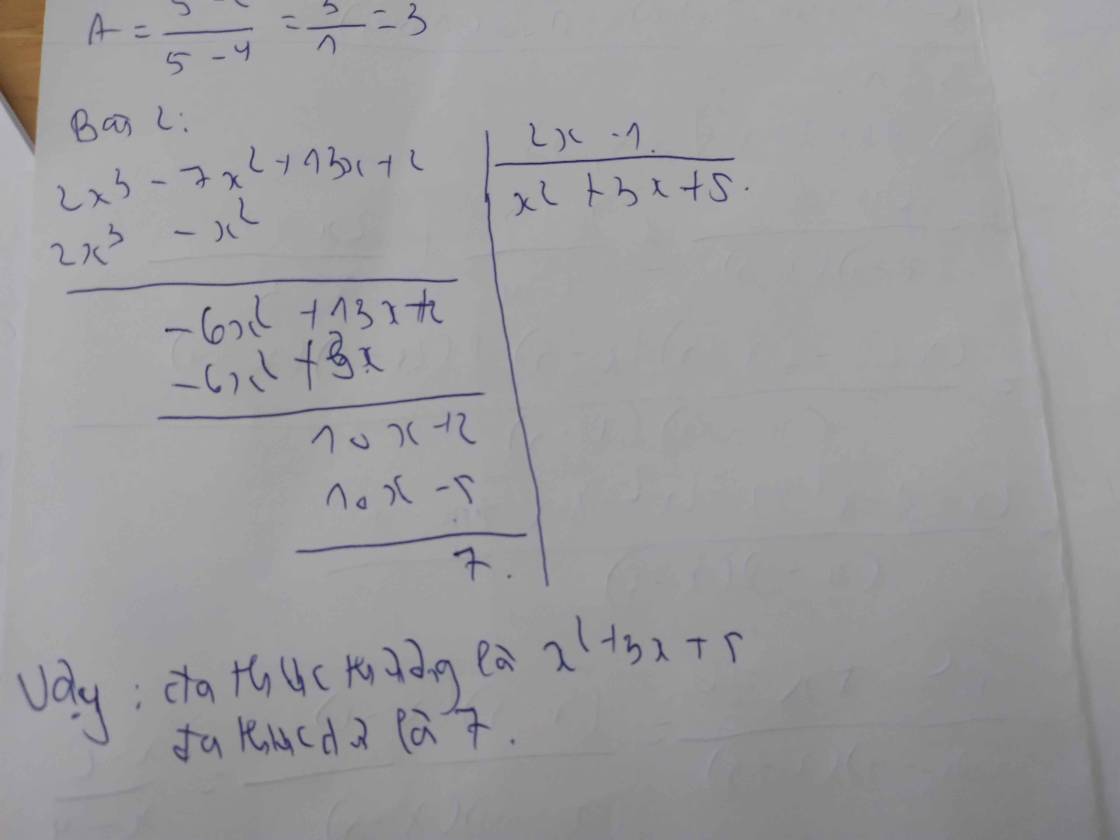Hãy nhập câu hỏi của bạn vào đây, nếu là tài khoản VIP, bạn sẽ được ưu tiên trả lời.

1: Ta có: \(A=\left(\dfrac{x^2-16}{x-4}-1\right):\left(\dfrac{x-2}{x-3}+\dfrac{x+3}{x+1}+\dfrac{x+2-x^2}{x^2-2x-3}\right)\)
\(=\left(x+4-1\right):\left(\dfrac{\left(x-2\right)\left(x+1\right)}{\left(x-3\right)\left(x+1\right)}+\dfrac{\left(x+3\right)\left(x-3\right)}{\left(x+1\right)\left(x-3\right)}+\dfrac{-x^2+x+2}{\left(x-3\right)\left(x+1\right)}\right)\)
\(=\left(x+3\right):\dfrac{x^2+x-2x-2+x^2-9-x^2+x+2}{\left(x-3\right)\left(x+1\right)}\)
\(=\left(x+3\right):\dfrac{x^2-9}{\left(x-3\right)\left(x+1\right)}\)
\(=\dfrac{\left(x+3\right)\left(x-3\right)\left(x+1\right)}{x^2-9}\)
\(=x+1\)
ĐKXĐ: \(x\notin\left\{4;3;-1\right\}\)
2: Để \(\dfrac{A}{x^2+x+1}\) nhận giá trị nguyên thì \(x+1⋮x^2+x+1\)
\(\Leftrightarrow x^2+x⋮x^2+x+1\)
\(\Leftrightarrow x^2+x+1-1⋮x^2+x+1\)
mà \(x^2+x+1⋮x^2+x+1\)
nên \(-1⋮x^2+x+1\)
\(\Leftrightarrow x^2+x+1\inƯ\left(-1\right)\)
\(\Leftrightarrow x^2+x+1\in\left\{1;-1\right\}\)
\(\Leftrightarrow x^2+x\in\left\{0;-2\right\}\)
\(\Leftrightarrow x^2+x=0\)(Vì \(x^2+x>-2\forall x\))
\(\Leftrightarrow x\left(x+1\right)=0\)
\(\Leftrightarrow\left[{}\begin{matrix}x=0\\x+1=0\end{matrix}\right.\Leftrightarrow\left[{}\begin{matrix}x=0\left(nhận\right)\\x=-1\left(loại\right)\end{matrix}\right.\)
Vậy: Để \(\dfrac{A}{x^2+x+1}\) nhận giá trị nguyên thì x=0

a: \(A=\left(\dfrac{2x^2+2}{x^3-1}+\dfrac{x^2-x+1}{x^4+x^2+1}-\dfrac{x^2+3}{x^3-x^2+3x-3}\right):\dfrac{1}{x-1}\)
\(=\left(\dfrac{2x^2+2}{\left(x-1\right)\left(x^2+x+1\right)}+\dfrac{x^2-x+1}{x^4+2x^2+1-x^2}-\dfrac{x^2+3}{x^2\left(x-1\right)+3\left(x-1\right)}\right)\cdot\dfrac{x-1}{1}\)
\(=\left(\dfrac{2x^2+2}{\left(x-1\right)\left(x^2+x+1\right)}+\dfrac{\left(x^2-x+1\right)}{\left(x^2+1\right)^2-x^2}-\dfrac{x^2+3}{\left(x-1\right)\left(x^2+3\right)}\right)\cdot\dfrac{x-1}{1}\)
\(=\left(\dfrac{2x^2+3}{\left(x-1\right)\left(x^2+x+1\right)}+\dfrac{x^2-x+1}{\left(x^2+1+x\right)\left(x^2+1-x\right)}-\dfrac{1}{x-1}\right)\cdot\dfrac{x-1}{1}\)
\(=\left(\dfrac{2x^2+3}{\left(x-1\right)\left(x^2+x+1\right)}+\dfrac{1}{x^2+x+1}-\dfrac{1}{x-1}\right)\cdot\dfrac{x-1}{1}\)
\(=\dfrac{2x^2+3+x-1-x^2-x-1}{\left(x-1\right)\left(x^2+x+1\right)}\cdot\dfrac{x-1}{1}\)
\(=\dfrac{x^2+1}{x^2+x+1}\)
b: Để A là số nguyên thì \(x^2+1⋮x^2+x+1\)
=>\(x^2+x+1-x⋮x^2+x+1\)
=>\(x⋮x^2+x+1\)
=>\(x^2+x⋮x^2+x+1\)
=>\(x^2+x+1-1⋮x^2+x+1\)
=>\(-1⋮x^2+x+1\)
=>\(x^2+x+1\in\left\{1;-1\right\}\)
=>\(x^2+x+1=1\)
=>x2+x=0
=>x(x+1)=0
=>\(x\in\left\{0;-1\right\}\)

a: \(A=\dfrac{x^2+1+1}{x^2+1}:\dfrac{x^2+1-2x}{\left(x-1\right)\left(x^2+1\right)}\)
\(=\dfrac{x^2+2}{x^2+1}\cdot\dfrac{\left(x-1\right)\left(x^2+1\right)}{\left(x-1\right)^2}=\dfrac{x^2+2}{x-1}\)
b: A nguyên
=>x^2-1+3 chia hết cho x-1
=>\(x-1\in\left\{1;-1;3;-3\right\}\)
=>\(x\in\left\{2;0;4;-2\right\}\)



Câu 1:
1: Ta có: \(P=\left(\dfrac{x^2}{x^2-3}+\dfrac{2x^2-24}{x^4-9}\right)\cdot\dfrac{7}{x^2+8}\)
\(=\left(\dfrac{x^2\left(x^2+3\right)}{\left(x^2-3\right)\left(x^2+3\right)}+\dfrac{2x^2-24}{\left(x^2-3\right)\left(x^2+3\right)}\right)\cdot\dfrac{7}{x^2+8}\)
\(=\dfrac{x^4+3x^2+2x^2-24}{\left(x^2-3\right)\left(x^2+3\right)}\cdot\dfrac{7}{x^2+8}\)
\(=\dfrac{x^4+5x^2-24}{\left(x^2-3\right)\left(x^2+3\right)}\cdot\dfrac{7}{x^2+8}\)
\(=\dfrac{x^4+8x^2-3x^2-24}{\left(x^2-3\right)\left(x^2+3\right)}\cdot\dfrac{7}{x^2+8}\)
\(=\dfrac{x^2\left(x^2+8\right)-3\left(x^2+8\right)}{\left(x^2-3\right)\left(x^2+3\right)}\cdot\dfrac{7}{x^2+8}\)
\(=\dfrac{\left(x^2+8\right)\left(x^2-3\right)}{\left(x^2-3\right)\left(x^2+3\right)}\cdot\dfrac{7}{x^2+8}\)
\(=\dfrac{7}{x^2+3}\)
Câu 2a đề sai, pt này ko giải được
2b.
\(P\left(x\right)=\left(2x+7\right)\left(x^2-4x+4\right)+\left(a+20\right)x+\left(b-28\right)\)
Do \(\left(2x+7\right)\left(x^2-4x+4\right)⋮\left(x^2-4x+4\right)\)
\(\Rightarrow P\left(x\right)\) chia hết \(Q\left(x\right)\) khi \(\left(a+20\right)x+\left(b-28\right)\) chia hết \(x^2-4x+4\)
\(\Leftrightarrow\left\{{}\begin{matrix}a+20=0\\b-28=0\end{matrix}\right.\) \(\Rightarrow\left\{{}\begin{matrix}a=-20\\b=28\end{matrix}\right.\)
3a.
\(VT=\dfrac{1}{1+x^2}+\dfrac{1}{1+y^2}=\dfrac{2+x^2+y^2}{1+x^2+y^2+x^2y^2}=1+\dfrac{1-x^2y^2}{1+x^2+y^2+x^2y^2}\le1+\dfrac{1-x^2y^2}{1+2xy+x^2y^2}\)
\(VT\le1+\dfrac{\left(1-xy\right)\left(1+xy\right)}{\left(xy+1\right)^2}=1+\dfrac{1-xy}{1+xy}=\dfrac{2}{1+xy}\) (đpcm)
3b
Ta có: \(n^3-n=n\left(n-1\right)\left(n+1\right)\) là tích 3 số nguyên liên tiếp nên luôn chia hết cho 6
\(\Rightarrow n^3\) luôn đồng dư với n khi chia 6
\(\Rightarrow S\equiv2021^{2022}\left(mod6\right)\)
Mà \(2021\equiv1\left(mod6\right)\Rightarrow2021^{2020}\equiv1\left(mod6\right)\)
\(\Rightarrow2021^{2022}-1⋮6\)
\(\Rightarrow S-1⋮6\)